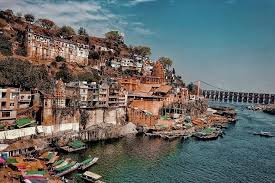Table of Contents
ToggleOmkareshwar Jyotirlinga

Omkareshwar Jyotirlinga
Omkareshwar is one of the twelve Jyotirlingas, which are sacred shrines dedicated to Lord Shiva, and it is located in the Khandwa district of Madhya Pradesh, India. The temple is situated on an island called Mandhata (or Omkareshwar) in the Narmada River. The island’s shape resembles the sacred Hindu symbol “Om,” which is the source of the name Omkareshwar.
Key Details about Omkareshwar Jyotirlinga:
1. Significance:
- Omkareshwar is considered one of the holiest and most revered Jyotirlingas in India. It holds a significant place in Hindu mythology and is believed to grant liberation (moksha) to devotees who visit and worship here.
- The temple is known for its association with the sound “Om” as it is said that the island on which the temple stands is shaped like the sacred “Om” symbol, further amplifying its spiritual significance.
2. History & Mythology:
- According to Hindu legend, the Omkareshwar temple was established after Lord Shiva, in his form as Omkareshwar, was worshipped by the demon king, Ravan, who performed severe penance to gain power. After Ravan’s penance, Lord Shiva granted him a boon and manifested as Omkareshwar to bless him.
- The island of Mandhata has been a site for worship for thousands of years. It is believed that Lord Shiva appeared as a Jyotirlinga to help people attain spiritual awakening.
3. Structure and Architecture:
- The Omkareshwar temple features traditional Hindu temple architecture. The main sanctum (garbhagriha) houses the Omkareshwar Jyotirlinga.
- The temple is known for its beautiful carvings, intricate sculptures, and large courtyards. The carvings on the walls and pillars depict various mythological figures and deities.
- The most unique aspect of the temple is the shape of the island, which forms the sacred symbol “Om” when viewed from above. This adds to its mystique and divine importance.
4. Location:
- Omkareshwar is located on Mandhata Island in the Narmada River, which makes it a picturesque and serene place of worship. The island can be reached by boat rides across the river.
- The temple is located approximately 77 km from Indore and about 130 km from Ujjain, two other famous pilgrimage sites in Madhya Pradesh.
5. Festivals:
- Mahashivaratri is the most significant festival celebrated at Omkareshwar. Thousands of devotees from all over the country visit the temple on this auspicious night to offer prayers and seek the blessings of Lord Shiva.
- Other festivals such as Navaratri and Makar Sankranti are also celebrated with grandeur, attracting a large number of pilgrims.
6. How to Reach:
- By Air: The nearest airport is in Indore, which is well-connected to major cities in India. From Indore, you can take a taxi or bus to reach Omkareshwar.
- By Train: The nearest railway station is Omkareshwar Road, which is well-connected to other major cities in India.
- By Road: Omkareshwar is accessible by road from major cities like Indore, Ujjain, and Khandwa.
7. Nearby Attractions:
- Mamleshwar Temple: Located on the opposite bank of the Narmada River, this temple is also dedicated to Lord Shiva and is considered equally important as Omkareshwar.
- Narmada River: The river that flows around the island is an integral part of the temple’s spiritual significance. Pilgrims often take a dip in the river to purify themselves.
- Rajgadh Fort: A historical fort located nearby with panoramic views of the surrounding areas.
8. Importance in Hinduism:
- Omkareshwar is revered by Hindus as a place that helps in removing sins and offering salvation. Pilgrims believe that visiting the temple and praying here can relieve them from worldly attachments and grant spiritual upliftment.
Visiting Omkareshwar is considered a deeply spiritual journey for those who seek the divine blessings of Lord Shiva. It is a place where nature, mythology, and spirituality come together, making it an important destination for devotees and tourists alike.
The history of Omkareshwar Jyotirlinga is deeply rooted in Hindu mythology and ancient traditions. It is one of the 12 Jyotirlingas, which are sacred shrines dedicated to Lord Shiva, and holds immense spiritual and religious significance. Here’s a detailed history of Omkareshwar:
Mythological Background:
1. The Origin of the Name:
- The name “Omkareshwar” is derived from the shape of the island on which the temple is located. The island is said to resemble the sacred Hindu symbol “Om,” which represents the sound and vibration of the universe and is considered the holiest of all sounds in Hinduism. This is one of the primary reasons why the temple is called Omkareshwar, symbolizing the divine form of Lord Shiva in the shape of “Om.”
2. The Story of King Mandhata and Lord Shiva’s Blessing:
- King Mandhata, an ancient king from the Ikshvaku dynasty, was an ardent devotee of Lord Shiva. According to the legend, Mandhata faced severe drought and famine in his kingdom. In search of a solution, he went to the forest and meditated upon Lord Shiva.
- Pleased with his devotion, Lord Shiva appeared before him and granted him the boon that his kingdom would prosper. In gratitude, Mandhata built a temple dedicated to Lord Shiva on the island that came to be known as Mandhata Island. Later, this place became known as Omkareshwar.
3. Ravana’s Penitence:
- According to another legend, Ravana, the demon king of Lanka, once performed severe penance to please Lord Shiva in order to gain immense power. He performed his penance on the Mandhata Island and made Lord Shiva appear before him.
- Shiva granted Ravana a boon and manifested as the Omkareshwar Jyotirlinga. There are variations in this story, with some versions claiming that Ravana took the Jyotirlinga to Lanka, but when he could not manage to carry it properly, it fell to its present location in Omkareshwar.
4. The Divine Manifestation:
- The most widely accepted myth surrounding the Omkareshwar Jyotirlinga is that Lord Shiva, in the form of a light (Jyotirlinga), manifested here for the benefit of all. It is said that the island and the surrounding Narmada River are blessed, as Lord Shiva’s divine presence purifies the surroundings and the devotees who come to worship.
5. The Two Lingas:
- The Omkareshwar temple is located on an island in the Narmada River and has two primary Lingas (symbolic representations of Lord Shiva):
- Omkareshwar Linga: This is the main Linga, representing Lord Shiva’s divine presence in the form of “Om.”
- Mamleshwar Linga: This is located on the opposite bank of the river and is also considered highly sacred. It is believed that both the Omkareshwar and Mamleshwar temples are part of the same divine shrine.
- The story suggests that Lord Shiva resides as Omkareshwar on the one side of the river and as Mamleshwar on the other, symbolizing the unity of the two forms of Shiva.
Historical Background:
The history of the Omkareshwar temple as an established religious site dates back centuries. The temple has undergone multiple renovations and expansions over time, but its religious significance has remained undiminished.
1. Ancient Times:
- The Omkareshwar temple is mentioned in ancient scriptures, including the Skanda Purana, where it is described as one of the most revered temples dedicated to Lord Shiva. The temple’s history is intertwined with the ancient worship of Lord Shiva in the region, and it is believed to have been a major pilgrimage destination for thousands of years.
2. The Gupta Period:
- During the Gupta period (approximately 4th to 6th centuries CE), Hinduism was in a phase of great revival, and the worship of Lord Shiva was flourishing. It is believed that the Omkareshwar temple may have seen significant construction or renovation during this period, as the Gupta rulers were great patrons of Hindu temples and rituals.
3. Medieval Period:
- During medieval times, the temple experienced both periods of prosperity and challenges. Like many other ancient temples, it was subjected to invasions, particularly during the Muslim rule in India, which led to damage and destruction of various Hindu shrines. However, the devotees of Lord Shiva never ceased to visit and maintain the sacredness of the place.
4. Modern Times:
- In the 19th and 20th centuries, the temple saw significant restoration efforts. The British and various local rulers helped in its upkeep. In modern times, the Omkareshwar temple has become one of the most important pilgrimage sites in Madhya Pradesh, drawing thousands of visitors every year, especially during Mahashivaratri and other religious festivals.
Key Historical Events:
- Construction of the Main Temple: While the specific time of the main temple’s construction is uncertain, it is believed that it was built and expanded upon over several centuries, starting from ancient times and continuing into the medieval period.
- Renovation by Rulers: Various regional rulers, particularly those of the Maratha and Rajput dynasties, contributed to the temple’s upkeep and renovation. Their support ensured that the Omkareshwar temple continued to remain a vital center of worship.
Conclusion:
Omkareshwar Jyotirlinga’s history is a blend of mythology, ancient devotion, and the ever-evolving story of Lord Shiva’s presence on Earth. The place has remained a symbol of divine power and spiritual awakening for centuries. Whether through its rich mythological tales, historical importance, or religious practices, Omkareshwar continues to stand as a beacon of faith and devotion to Lord Shiva.
The Omkareshwar Jyotirlinga is one of the 12 sacred Jyotirlingas, which are dedicated to Lord Shiva and considered to be among the holiest shrines for Hindus. Located in Omkareshwar, a town in Madhya Pradesh, India, this temple is not only a significant pilgrimage destination but also an architectural marvel with profound religious and spiritual significance. Here’s more detailed information about Omkareshwar Jyotirlinga:
1. Location:
- The Omkareshwar Temple is situated on Mandhata Island, also known as Omkareshwar Island, in the Narmada River. This island is shaped like the sacred “Om” symbol, which adds to its spiritual significance.
- The town of Omkareshwar is located about 77 km from Indore and 130 km from Ujjain, two other important pilgrimage centers in Madhya Pradesh. The town is well-connected by road and rail, making it accessible for pilgrims and tourists.
2. The Spiritual Significance of the Place:
- Omkareshwar is one of the 12 Jyotirlingas scattered across India, representing Lord Shiva in the form of divine light (Jyoti). The Jyotirlinga is considered to be a direct manifestation of Shiva’s energy.
- The island, which is in the shape of the Om symbol, is believed to be extremely powerful, symbolizing the connection between the divine and the earthly realm. The presence of the Omkareshwar Linga here signifies the cosmic energy of Lord Shiva.
3. Legend and Mythology:
- The most prominent legend associated with Omkareshwar is that of King Mandhata. The king was troubled by famine and drought in his kingdom and sought the blessings of Lord Shiva. He meditated on the Narmada River and prayed for the relief of his people. Lord Shiva appeared before him and granted his wishes, leading the king to establish a temple on the island.
- Another legend speaks of the demon king Ravana of Lanka, who performed severe penance at this site, seeking the blessings of Lord Shiva. Pleased by his devotion, Shiva appeared and granted him a boon. In some versions of the story, Ravana tried to carry the Jyotirlinga back to Lanka but was unable to do so, and the linga was thus left in Omkareshwar.
- The island is also associated with the story of Vishnu and Shiva fighting for supremacy, with Lord Vishnu appearing as the Varaha Avatar (the boar) and Lord Shiva in the form of Omkareshwar to settle the dispute.
4. Architecture and Structure:
- The Omkareshwar Temple is a stunning example of traditional Hindu temple architecture. The temple complex consists of several shrines, halls, and courtyards, with intricate carvings and sculptures depicting various gods and mythological figures.
- The main temple houses the Omkareshwar Jyotirlinga, which is an oval-shaped stone (lingam) and is worshipped by devotees throughout the year. The lingam is believed to be an eternal manifestation of Lord Shiva.
- There are also sub-shrines dedicated to other deities like Ganesha, Parvati, and Kartikeya within the temple complex.
- The architecture is designed to be in harmony with nature, with the Narmada River flowing around the temple, adding to its serene and divine atmosphere.
5. The Two Jyotirlingas:
- Omkareshwar is unique because it features two primary temples:
- Omkareshwar Linga: The main and most prominent linga of Lord Shiva.
- Mamleshwar Linga: Located across the river on the opposite bank in the town of Mamleshwar, this linga is considered equally important. It is believed that both the Omkareshwar and Mamleshwar temples together form a single divine entity, representing the duality of the universe in unity.
6. Festivals Celebrated:
- Mahashivaratri: The biggest festival celebrated at Omkareshwar. Devotees from all over India gather at the temple to offer prayers and participate in rituals, seeking blessings from Lord Shiva. The temple is illuminated and decorated, and thousands of pilgrims take a holy dip in the Narmada River.
- Navaratri: This festival, dedicated to the worship of the Goddess Durga, is also celebrated with great enthusiasm at Omkareshwar, attracting numerous devotees.
- Makar Sankranti and Kartik Purnima are also significant times when the temple sees a large influx of devotees.
7. Pilgrimage and the Narmada River:
- Pilgrims who visit Omkareshwar often bathe in the Narmada River, as it is considered a holy river that can purify sins and provide spiritual benefit. It is believed that taking a dip in the Narmada washes away all impurities and provides the soul with peace and sanctity.
- The town and the island are surrounded by beautiful views of the river and hills, providing a serene atmosphere for meditation and spiritual contemplation.
8. Nearby Attractions:
- Mamleshwar Temple: Located on the opposite bank of the Narmada River, this temple is dedicated to another form of Lord Shiva and is considered as important as Omkareshwar.
- Kailash Cave: A group of ancient rock-cut caves near Omkareshwar with inscriptions and sculptures of Lord Shiva.
- Rajgadh Fort: Located nearby, this historic fort offers panoramic views of the surrounding areas and is a reminder of the region’s rich history.
- Siddhanath Temple: Another nearby temple dedicated to Lord Shiva, believed to be built during ancient times.
9. How to Reach Omkareshwar:
- By Air: The nearest airport to Omkareshwar is Indore Airport (77 km away). From there, you can hire a taxi or take a bus to reach the temple.
- By Train: The nearest railway station is Omkareshwar Road Railway Station, which is well connected to cities like Indore, Ujjain, and Khandwa.
- By Road: Omkareshwar is accessible by road from Indore, Ujjain, and Khandwa. The town has good road connectivity to other major cities in Madhya Pradesh.
10. Spiritual Importance:
- Omkareshwar is considered one of the holiest sites for the worship of Lord Shiva. Devotees believe that a visit to Omkareshwar and the performance of rituals here can remove sins, grant prosperity, and lead to moksha (liberation).
- The divine combination of the Om symbol and the sacred river Narmada enhances the temple’s sanctity, making it a must-visit for those seeking spiritual peace and divine blessings.
Conclusion:
The Omkareshwar Jyotirlinga is a place where history, mythology, and spirituality merge. It represents a profound connection between humanity and the divine, with its rich legends, sacred waters, and serene surroundings. Whether you are a devout pilgrim, a seeker of peace, or a history enthusiast, Omkareshwar offers an unforgettable experience that touches the soul and renews one’s spiritual energy.

Omkareshwar Jyotirlinga






Recent Comments